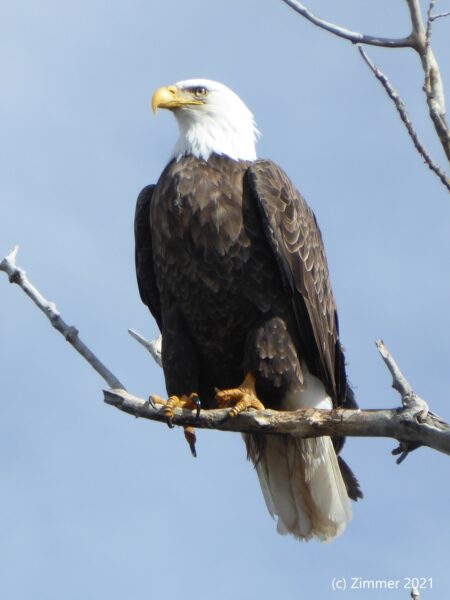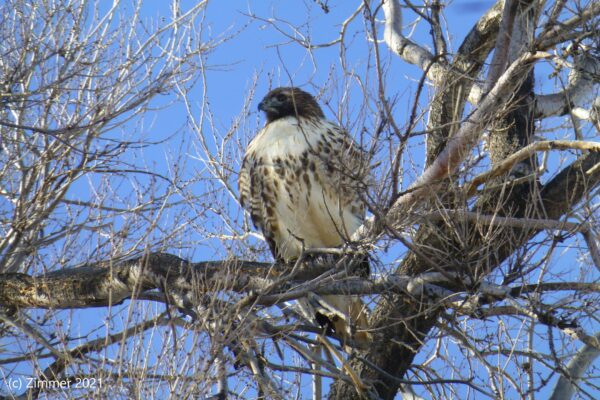Say you’re looking up at the sky and you see a large, soaring bird. You can tell it’s a raptor, but what species is it? Sometimes, especially from a distance, it can be difficult to distinguish raptors such as eagles and hawks, or other large birds.

First of all, what is a raptor? Raptors are birds of prey that share three characteristics that aid them in hunting: superb eyesight, a hooked bill, and sharp talons. Raptors include the birds we’re examining today — eagles and hawks — as well as owls (which you can read about in a previous post), and other species such as osprey, falcons, harriers, and kites.
Eagles and hawks belong to the family Accipitridae. This family includes a variety of species of both eagles and hawks, each with their own characteristics. There are some basic differences, however, that you can use to tell the birds apart, especially in flight. One of the most noticeable differences is their size. Eagles are much larger than hawks, and have longer wingspans. Hawks have a similar appearance, but if you look carefully, you will notice that the wings of hawks tend to be more rounded, and they have short, broad, rounded tails and a stocky build. Eagles tend to look larger overall, with straighter wings (sometimes described as “plank-like”), and an overall heavier look. Both hawks and eagles fly high up, taking advantage of thermals (rising columns of warm air) to soar. Hawks will sometimes soar with wings held in a dihedral (a shallow v-shape), while eagles soar on flat or only slightly-raised wings.

Colorado has two eagle species: Bald Eagles, which are dark in color but have bright white heads and tails, and Golden Eagles, which are dark all over except for the golden napes of their necks (which can be difficult to see on a bird in flight). Hawks, on the other hand, can range in color from very light to dark. Our most common Colorado hawk species is the Red-tailed Hawk, which is generally light in color underneath. It can be identified by its large size and characteristic ruddy tail, as suggested in its name. Red-tails also have a darkly-colored bar on the front edges of their open wings. This can be visible even on a bird that is soaring fairly high. On a perched bird, there are a few other markings that will tell you it’s a Red-tailed Hawk. One is the “belly band,” a darker mottled band contrasting with the lighter underside of the bird. A second is a V-shaped white spotting on the back, sometimes referred to as “backpack lines.”
This is only a basic overview of the differences between these two birds. Each raptor species has its own unique characteristics. There are also many other large birds that soar high in the sky, so it’s important to be aware that you could also be looking at an osprey, falcon, or even a non-raptor like pelicans and vultures. Being able to identify the different species can be fun and rewarding, and there are many resources available to help you. Hawkwatch International’s Raptor ID Fact Sheets are useful and easy to understand, and Colorado Parks & Wildlife’s Colorado Birding Trail website and guides include information on viewing birds in all parts of the state. In addition, some of the helpful resources available from the State Publications Library include the Colorado State Parks Raptor Monitoring Handbook; How to Search for Raptor Nests; and from the Colorado’s Wildlife Company series, The Hawks of Summer and An Eye For Eagles. Finally, if you’re interested in learning about other raptor species beyond eagles and hawks, see Colorado Parks & Wildlife’s video series, Uncommon Raptors of Colorado.
- How to Spot the Differences Between Eagles and Hawks - August 16, 2021
- How Transportation Projects Help Tell the Story of Colorado’s Past - August 9, 2021
- Time Machine Tuesday: The Night the Castlewood Canyon Dam Gave Way - August 3, 2021